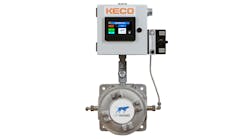Manfred Jagiella, member of Endress+Hauser's Executive Board
In an extraordinarily detailed series of presentations, Endress+Hauser's leadership laid out their latest technical and organizational strategies in an online press conference on Feb. 8 that covered process analytics, corporate acquisitions, digitalization and other advances for meeting the needs of its customers worldwide.
For instance, laser-based analysis technologies accounted for about a quarter of Endress+Hauser's sales in 2021, and culminated in it's forming a new company, Endress+Hauser Optical Analysis, at the start of this year. This will reportedly make it possible for traditional flow and level technologies to also be used for measuring material properties such as density and viscosity.
"Creating Endress+Hauser Optical Analysis moved ahead our analysis strategy. Raman spectroscopy and tunable diode laser absorption spectroscopy (TDLAS) fit perfectly as advanced technologies in our analysis portfolio, and create new opportunities for our customers through added-value innovations," says Manfred Jagiella, member of Endress+Hauser's Executive Board. "Raman spectroscopy is an ideal method for users in the life sciences industry, for example in vaccine production. TDLAS opens up further opportunities for us in the global market for gas analysis. Merging SpectraSensors and Kaiser Optical Systems puts us in an even better position to solve customers’ challenges by bundling our expertise in laser spectroscopy. Together with Endress+Hauser Liquid Analysis and Analytik Jena, we have an extremely strong analysis portfolio for customers worldwide."
In fact, Endress+Hauser Liquid Analysis and Analytik Jena are already developing a common platform for data management between lab and process applications. This Netilion IIoT ecosystem will serve as a data link to give users valuable information, and will also be the basis for future digital services.
To bring advanced analysis processes to its users, Endress+Hauser Optical Analysis added existing structures, personnel and know-how to its center of competence for process analyzers in Lyon, France, which has 21 staffers, and supports 40 sales and service engineers across Europe. It also added new structures to support its customers, and plans to expand this model in North America and Asia. The center is certified in accordance with ISO 9001, ATEX and IECEX requirements.
Jagiella reported that Endress+Hauser is likewise concentrating on its core product portfolio for analyzing gas, liquids and solids. "We'll expand our successful platforms for liquid analysis, such as Liquiline and Memosens, with new sophisticated functions and several added parameters, such as oil in water," added Jagiella. "We'll also bundle our core expertise and our know-how across lab and process analytics even more extensively. Our innovative CA80 family of analyzers is growing by adding parameters. We sold more than 2,000 analyzers in 2021, mainly for applications in the wastewater and power plant sectors. Likewise, Endress+Hauser Optical Analysis is offering its new J22 gas analyzer, which is the first product in our new TDLAS instrument platform. Plus, we're also investing in further development of the Raman spectroscopy technology for new applications."
Products featured in the presentations included:
- J22 TDLAS gas analyzer, which includes Endress+Hauser's Heartbeat diagnostic, monitoring and verification, comprehensive process monitoring, alarms for critical measurement values, web server for data access, robust enclosure, improved isolation and enclosure heating, and easy-to-remove gas sample cells.
- CKI50 process spectrometer from Endress+Hauser's Memosens Wave family detects colors by employing VIS spectroscopy. It scans the 380 nm to 830 nm wavelength range of the electromagnetic spectrum and outputs the color in the form of CIE L*a*b* values, a three-dimensional color space model in which every color location is defined by the coordinates L*, a* and b*. Mathematical analysis models for analyzing spectroscopic results are stored in the instrument.
- Proline Promass Q Coriolis flowmeter has a density specification of 0.1 kg/m3, and provides dedicated application software packages for specific industries from food to oil refineries, and a web server. It will soon be available with a nominal diameter range of DN 25 with the premium-density option, which is usually deployed in bypass as a pure density monitor.
- Solitrend continuous, process-based moisture sensors are based on TDR technology to precisely determine the water content of bulk solids based on the runtime of a radar impulse across a ceramic measurement cell, using the physical effect of the increasing dielectric constant as it relates to increased water content. These moisture sensors are installed directly in the bulk solid stream with the help of a bracket to ensure fast and reliable measurements.
- CA79 total organic carbon (TOC) analyzer operates with a proven UV-oxidation process and differential conductivity measurements. With a response time (t90) of 50 seconds, it constantly delivers reliable, precise measurement values, so users can immediately recognize if the quality of ultrapure water has deteriorated and react immediately to prevent contamination.




